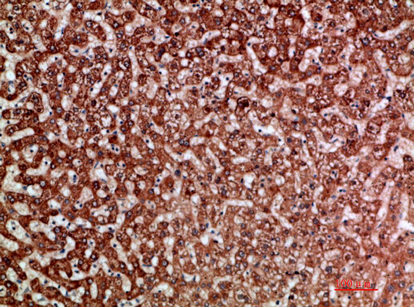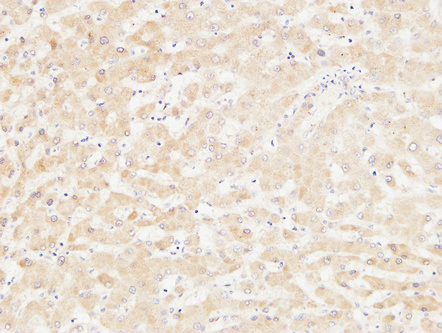ANG I Polyclonal Antibody
- 产品详情
- 实验流程
- 背景知识
Application
| IHC-P |
|---|---|
| Primary Accession | P03950 |
| Reactivity | Human |
| Host | Rabbit |
| Clonality | Polyclonal |
| Calculated MW | 16550 Da |
| Gene ID | 283 |
|---|---|
| Other Names | Angiogenin (EC 3.1.27.-) (Ribonuclease 5) (RNase 5) |
| Dilution | IHC-P~~IHC-p 1:50-200, ELISA 1:10000-20000 |
| Format | Liquid in PBS containing 50% glycerol, 0.5% BSA and 0.09% (W/V) sodium azide. |
| Storage Conditions | -20℃ |
| Name | ANG {ECO:0000303|PubMed:11919285, ECO:0000312|HGNC:HGNC:483} |
|---|---|
| Function | Secreted ribonuclease that can either promote or restrict cell proliferation of target cells, depending on the context (PubMed:12051708, PubMed:1400510, PubMed:19332886, PubMed:20129916, PubMed:21855800, PubMed:23047679, PubMed:23843625, PubMed:2424496, PubMed:2459697, PubMed:2730651, PubMed:27518564, PubMed:28176817, PubMed:29100074, PubMed:29748193, PubMed:3122207, PubMed:32510170, PubMed:38718836, PubMed:8159680, PubMed:8570639, PubMed:8622921, PubMed:9578571). Endocytosed in target cells via its receptor PLXNB2 and translocates to the cytoplasm or nucleus (PubMed:29100074, PubMed:32510170). Under stress conditions, localizes to the cytoplasm and promotes the assembly of stress granules (SGs): specifically cleaves a subset of tRNAs within anticodon loops to produce tRNA- derived stress-induced fragments (tiRNAs), resulting in translation repression and inhibition of cell proliferation (PubMed:1400510, PubMed:19332886, PubMed:20129916, PubMed:21855800, PubMed:23047679, PubMed:27518564, PubMed:29100074, PubMed:29748193, PubMed:32510170, PubMed:38718836). tiRNas also prevent formation of apoptosome, thereby promoting cell survival (By similarity). Preferentially cleaves RNAs between a pyrimidine and an adenosine residue, suggesting that it cleaves the anticodon loop of tRNA(Ala) (32-UUAGCAU-38) after positions 33 and 36 (PubMed:3289612, PubMed:38718836). Cleaves a subset of tRNAs, including tRNA(Ala), tRNA(Glu), tRNA(Gly), tRNA(Lys), tRNA(Val), tRNA(His), tRNA(Asp) and tRNA(Sec) (PubMed:31582561). Under growth conditions and in differentiated cells, translocates to the nucleus and stimulates ribosomal RNA (rRNA) transcription, including that containing the initiation site sequences of 45S rRNA, thereby promoting cell growth and proliferation (PubMed:12051708, PubMed:15735021, PubMed:27518564, PubMed:29100074, PubMed:8127865). Angiogenin induces vascularization of normal and malignant tissues via its ability to promote rRNA transcription (PubMed:19354288, PubMed:4074709, PubMed:8448182). Involved in hematopoietic stem and progenitor cell (HSPC) growth and survival by promoting rRNA transcription in growth conditions and inhibiting translation in response to stress, respectively (PubMed:27518564). Mediates the crosstalk between myeloid and intestinal epithelial cells to protect the intestinal epithelial barrier integrity: secreted by myeloid cells and promotes intestinal epithelial cells proliferation and survival (PubMed:32510170). Also mediates osteoclast-endothelial cell crosstalk in growing bone: produced by osteoclasts and protects the neighboring vascular cells against senescence by promoting rRNA transcription (By similarity). |
| Cellular Location | Secreted. Nucleus. Nucleus, nucleolus. Cytoplasm, Stress granule. Note=The secreted protein is rapidly endocytosed by target cells following interaction with PLXNB2 receptor and translocated to the cytoplasm and nucleus (PubMed:29100074). In the nucleus, accumulates in the nucleolus and binds to DNA (PubMed:12051708). |
| Tissue Location | Expressed predominantly in the liver (PubMed:2440105). Also detected in endothelial cells and spinal cord neurons (PubMed:17886298, PubMed:2440105) |
For Research Use Only. Not For Use In Diagnostic Procedures.
Provided below are standard protocols that you may find useful for product applications.
BACKGROUND
Binds to actin on the surface of endothelial cells; once bound, angiogenin is endocytosed and translocated to the nucleus. Stimulates ribosomal RNA synthesis including that containing the initiation site sequences of 45S rRNA. Cleaves tRNA within anticodon loops to produce tRNA-derived stress-induced fragments (tiRNAs) which inhibit protein synthesis and triggers the assembly of stress granules (SGs). Angiogenin induces vascularization of normal and malignant tissues. Angiogenic activity is regulated by interaction with RNH1 in vivo.
终于等到您。ABCEPTA(百远生物)抗体产品。
点击下方“我要评价 ”按钮提交您的反馈信息,您的反馈和评价是我们最宝贵的财富之一,
我们将在1-3个工作日内处理您的反馈信息。
如有疑问,联系:0512-88856768 tech-china@abcepta.com.























 癌症的基本特征包括细胞增殖、血管生成、迁移、凋亡逃避机制和细胞永生等。找到癌症发生过程中这些通路的关键标记物和对应的抗体用于检测至关重要。
癌症的基本特征包括细胞增殖、血管生成、迁移、凋亡逃避机制和细胞永生等。找到癌症发生过程中这些通路的关键标记物和对应的抗体用于检测至关重要。 为您推荐一个泛素化位点预测神器——泛素化分析工具,可以为您的蛋白的泛素化位点作出预测和评分。
为您推荐一个泛素化位点预测神器——泛素化分析工具,可以为您的蛋白的泛素化位点作出预测和评分。 细胞自噬受体图形绘图工具为你的蛋白的细胞受体结合位点作出预测和评分,识别结合到自噬通路中的蛋白是非常重要的,便于让我们理解自噬在正常生理、病理过程中的作用,如发育、细胞分化、神经退化性疾病、压力条件下、感染和癌症。
细胞自噬受体图形绘图工具为你的蛋白的细胞受体结合位点作出预测和评分,识别结合到自噬通路中的蛋白是非常重要的,便于让我们理解自噬在正常生理、病理过程中的作用,如发育、细胞分化、神经退化性疾病、压力条件下、感染和癌症。












